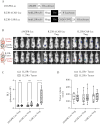IL23R-Specific CAR Tregs for the Treatment of Crohn's Disease
- PMID: 39252592
- PMCID: PMC11945296
- DOI: 10.1093/ecco-jcc/jjae135
IL23R-Specific CAR Tregs for the Treatment of Crohn's Disease
Abstract
Background and aims: Regulatory T cells (Tregs) are key regulators in maintaining tissue homeostasis. Disrupted immune homeostasis is associated with Crohn's disease (CD) pathogenesis. Thus, Treg therapy represents a promising long-acting treatment to restore immune balance in the diseased intestine. Chimeric antigen receptor (CAR) T-cell therapy has revolutionized cancer treatment. This innovative approach also provides the opportunity to improve therapy for CD. By targeting a disease-relevant protein, interleukin-23 receptor (IL23R), we engineered Tregs expressing IL23R-CAR for treating active CD.
Methods: Intestinal IL23R expression from active CD was verified by immunohistochemical analysis. Phenotypic and functional characteristics of IL23R-CAR Tregs were assessed using in vitro assays and their migration capacity was monitored in a xenograft tumor model. Transcriptomic and proteomic analyses were performed to associate molecular profiles with IL23R-CAR Treg activation against colon biopsy-derived cells from active CD patients.
Results: Our study showed that IL23R-CAR displayed negligible tonic signaling and a strong signal-to-noise ratio. IL23R-CAR Tregs maintained regulatory phenotype during in vitro expansion, even when chronically exposed to proinflammatory cytokines and target antigen. IL23R engagement on IL23R-CAR Tregs triggered CAR-specific activation and significantly enhanced their suppressive activity. Also, IL23R-CAR Tregs migrated to IL23R-expressing tissue in humanized mice. Finally, IL23R-CAR Tregs elicited a specific activation against colon biopsy-derived cells from active CD, suggesting an efficient CAR engagement in active CD. Molecular profiling of CD patient biopsies also revealed transcriptomic and proteomic patterns associated with IL23R-CAR activation.
Conclusions: Overall, our results demonstrate that IL23R-CAR Tregs represent a promising therapy for active CD.
Keywords: CAR Treg; Crohn’s disease; IBD; IL23R; cell therapy.
© The Author(s) 2024. Published by Oxford University Press on behalf of European Crohn’s and Colitis Organisation.
Conflict of interest statement
All authors are current or former employees of Sangamo Therapeutics. Sangamo Therapeutics has filed patent applications (PCT/EP2019/059590 and PCT/US2022/035028) covering the technology described in this paper.
Figures







Comment in
-
IL-23R-Specific Chimeric Antigen Receptor Tregs in Crohn's Disease: Dawn of a Cellular Immunotherapeutic Era?J Crohns Colitis. 2025 Apr 4;19(4):jjae159. doi: 10.1093/ecco-jcc/jjae159. J Crohns Colitis. 2025. PMID: 39432833 No abstract available.
References
-
- Colombel JF, Narula N, Peyrin-Biroulet L.. Management strategies to improve outcomes of patients with inflammatory bowel diseases. Gastroenterology 2017;152:351–61.e5. - PubMed
-
- Noor NM, Verstockt B, Parkes M, Lee JC.. Personalised medicine in Crohn’s disease. Lancet Gastroenterol Hepatol 2020;5:80–92. - PubMed
-
- Kamada N, Seo SU, Chen GY, Nunez G.. Role of the gut microbiota in immunity and inflammatory disease. Nat Rev Immunol 2013;13:321–35. - PubMed
-
- Baumgart DC, Sandborn WJ.. Crohn’s disease. Lancet 2012;380:1590–605. - PubMed
-
- Torres J, Mehandru S, Colombel JF, Peyrin-Biroulet L.. Crohn’s disease. Lancet 2017;389:1741–55. - PubMed
MeSH terms
Substances
Grants and funding
LinkOut - more resources
Full Text Sources
Medical

